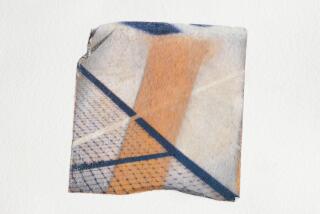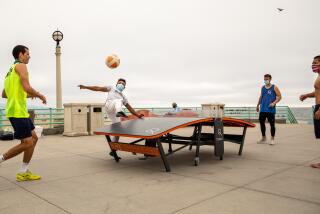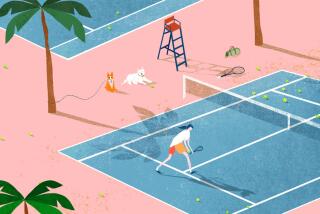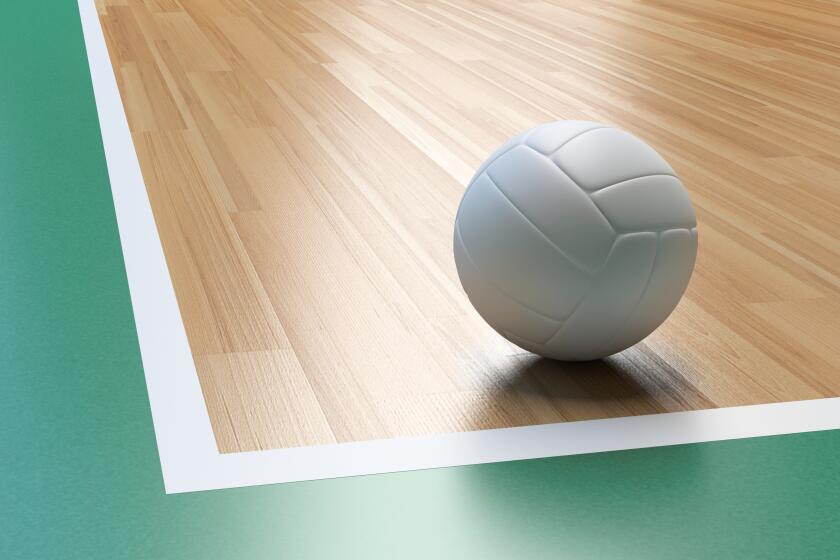Chess for the Body : An Aura of Gentility Remains as the Strategy Sport Gains Popularity at Orange County Athletic Clubs, but the Idea Is Still to Punish--Politely
In a world where even tennis players are prone to tantrums, squash still lays claim to the phrase “gentleman’s game,” a sport in which the term boast refers not to a bit of bragging but to a certain type of shot.
Growing up in England as a game of the aristocracy, claimed in its American form by the Ivy League schools, squash has retained an aura of upper-crust gentility even as its popularity has spread around the world. “The first thing that attracted me to the sport was the camaraderie on the court,” said Ron Leon, an Orange County squash coach who came to the game from racquetball.
Don’t let the on-court civility blind you to the game’s real nature, however. Squash is a “game of attrition” in which rallies can last 100 shots or more, Leon said. “The idea really is to punish your opponent.”
Added Zac Toohey, a local squash pro who was once ranked one of the Top 100 players in the world: “You’ve got to try and work your opponent around the court until he’s exhausted.” And do it politely.
When Leon started playing the game in 1986, he had to drive from Orange County to Los Angeles to find a court, and even there they were scarce. “There was really no squash in Southern California,” he said. Now, four major Orange County health clubs have squash courts, with several hundred active players among them.
Some of that growth has come at the expense of racquetball, which has been on the decline since its late ‘70s heyday. Two clubs, LA Fitness and University Athletic Club (where Leon is director of squash) in Newport Beach, converted some of their racquetball courts to squash courts.
When the two huge Irvine clubs were built across from each other off the 405 Freeway (Sports Club/Irvine and the Sporting Club at Lakeshore Towers), both opened with more squash courts than racquetball courts.
“A lot of people are switching from racquetball to squash and not coming back,” said Toohey, who is the pro at Sports Club/Irvine (the club will host the Pacific Coast Squash Racquets Assn. 1993 “Softball” Championship on April 16 to 18).
“A lot of the racquetball players have been switching over to squash because they can get a better workout,” said Devin LaBollita, owner of Devin’s Pro Shop in Newport Beach. Also, “The strategy is a lot more intense in squash.”
Squash is “one of the more popular programs we have right now,” said Tom Hobbs, assistant manager of the University Athletic Club in Newport Beach. “Racquetball seems to be a little bit in decline, and squash seems to be picking up some of the slack.”
The game is similar to racquetball in several ways--it’s played indoors, with racquets, for instance--but different in significant ways as well. The international or “softball” version of squash played in Orange County uses a small, squishy rubber ball that does not bounce nearly as hard as a racquetball, a difference that influences the game in several ways.
(The “hardball” or North American version of squash popular on the East Coast uses a harder ball and a bigger court; it is generally declining in favor of the game’s international version).
Because the ball does not bounce as far, squash players must move constantly to retrieve shots. In racquetball, Leon said, “you can pretty much stand in the middle of the court and the ball comes to you,” while in squash, “you have to cover the entire court.”
In squash, the ball must hit the front wall above a line (the “tin”) painted 19 inches above the floor. This, combined with the soft ball, eliminates the “kill” shots that usually end a racquetball rally after a few hits. In squash, there are no “winners.”
“A player who is enthusiastic and anticipates well can return any shot” in squash, Leon said. Rallies, then, become games of patience, as each player tries to pull his opponent out of position little by little, finally putting a shot out of reach. Good players are planning four to five shots ahead, Leon said, one reason why the game is sometimes called “physical chess.”
“You’re trying to set up the (other) player,” Toohey said. “The more you can turn the person around, the harder it is for them to recover.”
The long rallies, combined with all the running around, make squash one of the toughest workouts in sports. According to Leon, an active tennis match will burn 250 calories an hour, racquetball about 500 an hour. Squash will burn as much as 1,500 calories an hour.
“Squash players are considered the best-conditioned athletes,” Leon said. “Top players can lose six to eight pounds in a tough match.”
The wooden floors of racquetball courts are usually varnished, but that’s against the rules in squash--all the sweat lost would make them too slick.
The international version of squash spread throughout the British Empire in the 1950s, with places such as Pakistan, South Africa and Australia producing some of the best players (Toohey is an Australian who competed on an English team that won the British National Championship in 1989).
Squash is only now beginning to catch on in Southern California, which is one of three areas in the country with the game’s fastest growth rate (the others are Houston and Seattle). Still, Leon said, “A lot of people don’t even know squash is available in Orange County.”
Some of the people who are playing are transplants from back East or, like, Toohey, other squash-playing spots on the globe. The others, including many women, come from racquetball or other sports.
The only places to play in Orange County are expensive private clubs. Leon, who has been working since the mid-’80s to popularize the sport, hopes it will soon spread to more public arenas and finally shed some of its upper-class image, which he feels has hurt the game’s growth.
“I think the Ivy League image has made the game seem elitist,” he said. Despite the game’s growth in the past few years, he said, Southern California is “about 20 years behind the rest of the world.”
More to Read
Go beyond the scoreboard
Get the latest on L.A.'s teams in the daily Sports Report newsletter.
You may occasionally receive promotional content from the Los Angeles Times.










